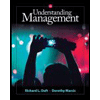
To differentiate: The different types of groups.
Explanation of Solution
Group:
It is a situation where two or more individuals come together and operate together to achieve a common goal and objectives. There are two types of groups; formal and informal.
Formal groups:
A formal group is a designated structure directed by the organization established to achieve particular goals and objectives as a group. In formal groups, the behavior of the individuals must be directed towards the organization's goals and under the regulations of the organization. An example of a formal group is the crew of an airline flight.
Informal groups:
It is the group formed by the employees of an organization outside the boundary of an organization. These are done by employees to have social contact. An example of an informal group is three members of the HR, Finance, and Operations department meeting outside for lunch or dinner regularly.
Want to see more full solutions like this?
Chapter 9 Solutions
Essentials of Organizational Behavior (14th Edition)
- What are the obstacles to incorporating stress management techniques? How can we overcome these obstacles?arrow_forwardIn the 2016, "ATB: digital disruption in the parking meter industry" perform a finanacial analysis and make a chart similar to this one 2013 2014 Current Ratio 1.88 1.41 Quick Ratio 0.49 0.29 Debt to Equity 0.95 1.92 Return on Assets 5.47% 2.76% Net Profit Margin 2.71% 1.89%arrow_forwardPerform a VRIO Analysis on the 2016 "ATB: Digital disruption in the parking meter industry" and make a chart similar to this one V R I O Topic Y Y Y Y Relations with John Deere and Paccar Y N N Y Customer Relations Y Y Y Y Acquisition and Integration Process Y Y Y N Cervus Leadership University Y Y N Y Proactive Management Y Y N Y Financial Position Y N N N Scale of Organizationarrow_forward
- How do incorporated stress management techniques impact future emotional strength and wellness? What are the lesson learned from incorporating stress management techniques in the past that reflects developing emotional resilience?arrow_forwardIn the 2016 "ATB: digital disruption in the parking meter industry" 1. Identification + use of suitable decision criteriato rank options▪ Development of practical options in relation toidentified issue(s) + prior analysis▪ Qualitative + financial evaluation andcomparison of options 2 2. Detailed + practical action to putrecommendations in place (both short & long-run)▪ Timeline of sequence of actions, e.g. Ganttchart▪ Controls + timeline to measure if plan is ontrack▪ Contingency planarrow_forwardIn the 2016, "ATB: digital disruption in the parking meter industry" case provide a financial analysis of firmarrow_forward
 Management, Loose-Leaf VersionManagementISBN:9781305969308Author:Richard L. DaftPublisher:South-Western College Pub
Management, Loose-Leaf VersionManagementISBN:9781305969308Author:Richard L. DaftPublisher:South-Western College Pub Understanding Management (MindTap Course List)ManagementISBN:9781305502215Author:Richard L. Daft, Dorothy MarcicPublisher:Cengage Learning
Understanding Management (MindTap Course List)ManagementISBN:9781305502215Author:Richard L. Daft, Dorothy MarcicPublisher:Cengage Learning


